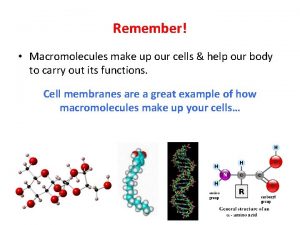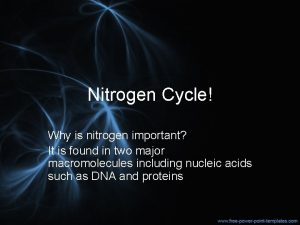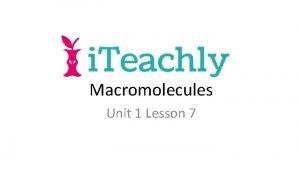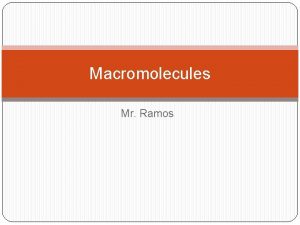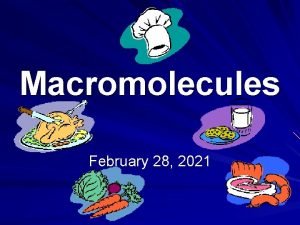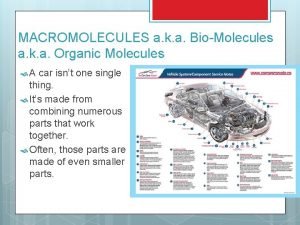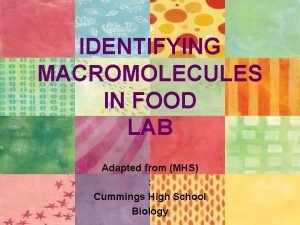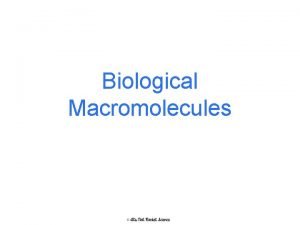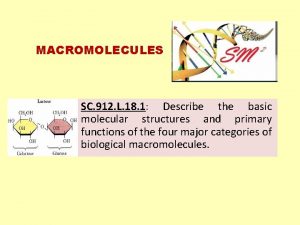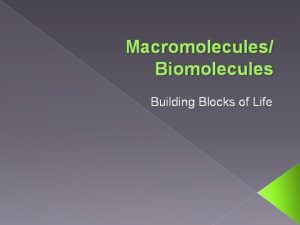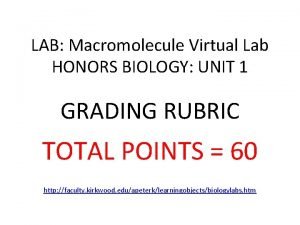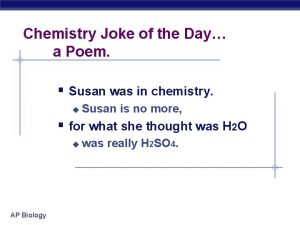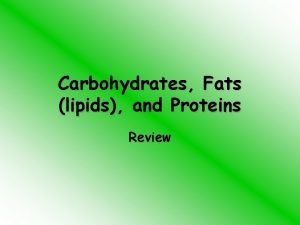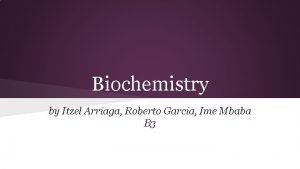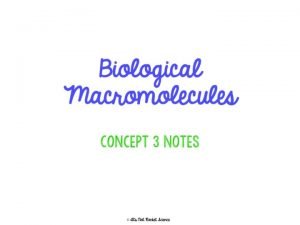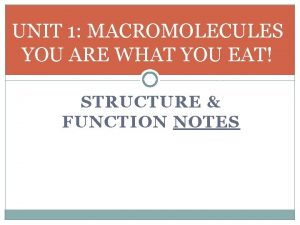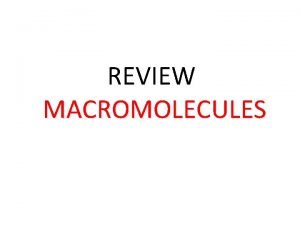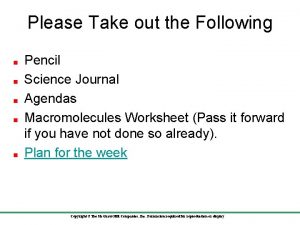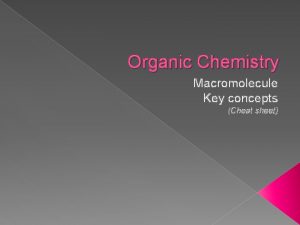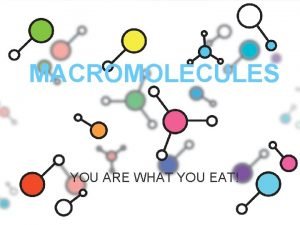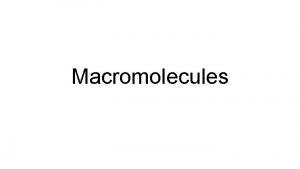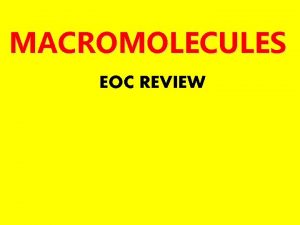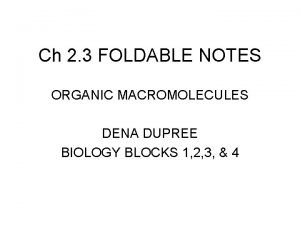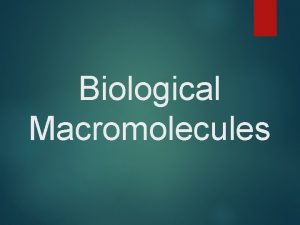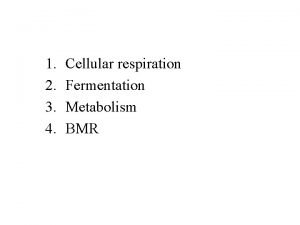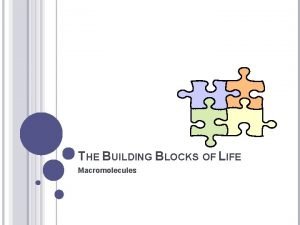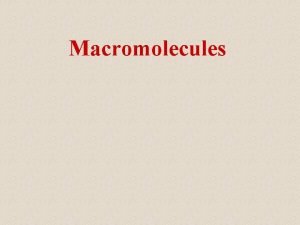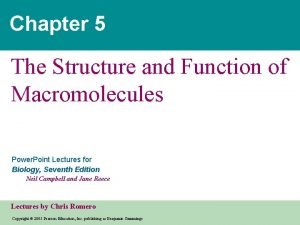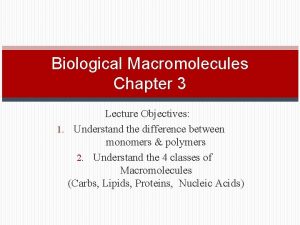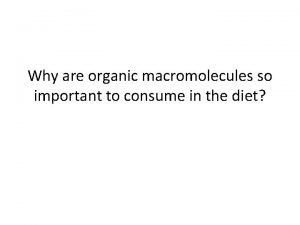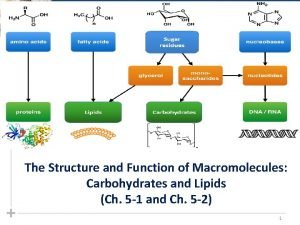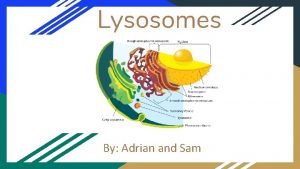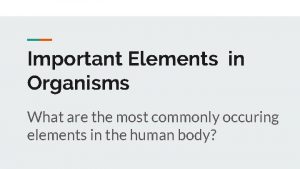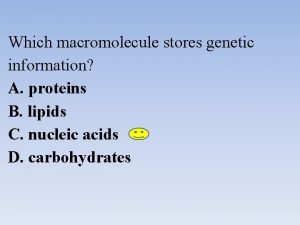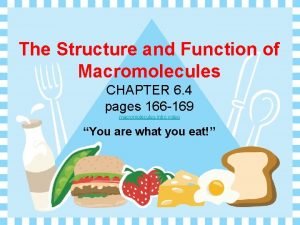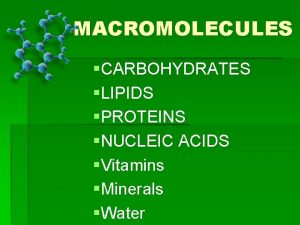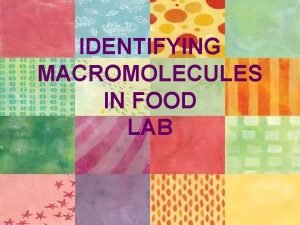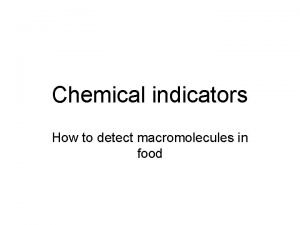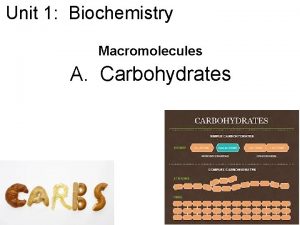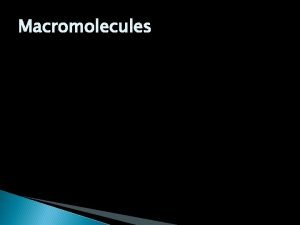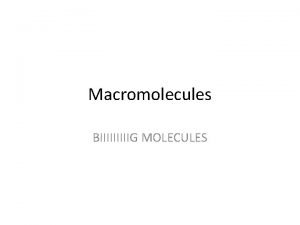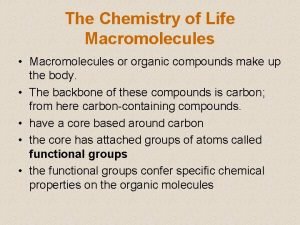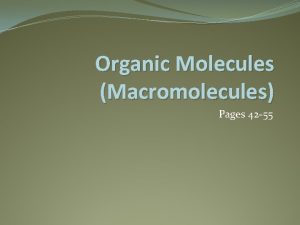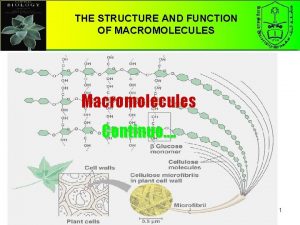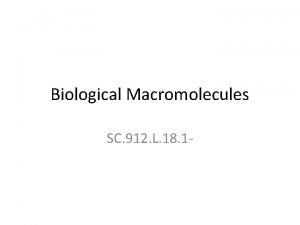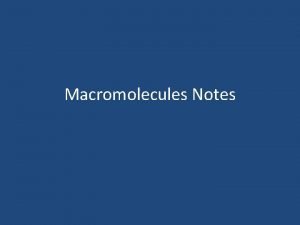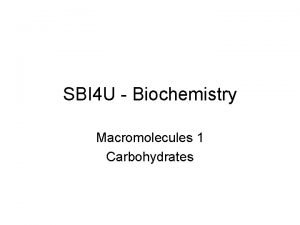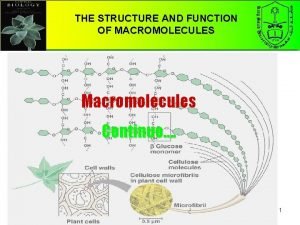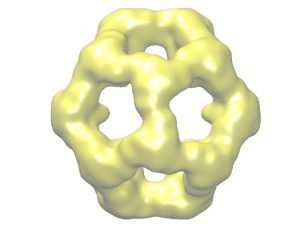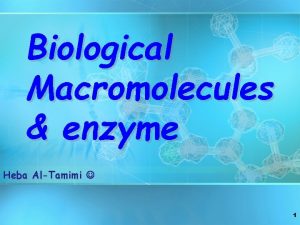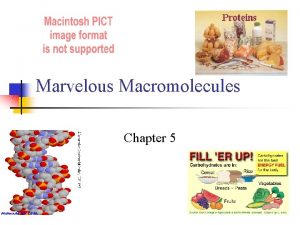Macromolecules Unit 1 Lesson 7 Macromolecules Students will















































- Slides: 47

Macromolecules Unit 1 Lesson 7

Macromolecules Students will be able to: • Describe the structure of the four groups of macromolecules carbohydrates, lipids, proteins and nucleic acids. • Describe how the four groups of macromolecules are formed. • Compare chemical structures of the four groups of macromolecules and relate this to their role in living organisms.

Macromolecules Key Vocabulary: Macromolecule, monomer, polymer, condensation reaction, carbohydrate, monosaccharide, disaccharide, polysaccharide, lipid, fatty acid, protein, amino acid, enzyme, hormone, nucleic acid, DNA, RNA, nucleotide.

Macromolecules • The six main elements found in living things are: C carbon H O hydrogen oxygen N nitrogen S P sulfur phosphorous

Macromolecules • These six atoms bond together in a variety of combinations to form molecules which make up the structures found in the cells of living things. • These molecules then join together to form much larger structures known as macromolecules.

Macromolecules • All macromolecules have carbon as their main element.

Macromolecules • The four macromolecules you will be required to know about for this course are carbohydrates, proteins, lipids and nucleic acids. LIPIDS NUCLEIC ACIDS PROTEINS

Macromolecules The Role of Carbon in Living Things • A carbon atom has four electrons in its valence shell. • To become stable, carbon will form four covalent bonds to fill its outer valence shell. electrons neutron - proton + + + - - A carbon atom with: • 6 electrons • 6 protons • 6 neutrons valence shell

Macromolecules The Role of Carbon in Living Things • These bonds may be with other carbon atoms, or with other elements such as hydrogen and oxygen. • When two carbon atoms form a covalent bond, each atom can share: one electron to form a single bond three electrons to form a triple bond two electrons to form a double bond

Macromolecules The Role of Carbon in Living Things • Carbon atoms bond to each other in different ways to form compounds of various shapes including, straight-chain, branchedchain, or ring compounds. • This creates a huge variety of compounds

Macromolecules Role of Carbon Comprehension Check Can you. . . ü Name the four carbon-based macromolecules? ü Name three shapes of the molecules carbon forms? ü Draw a carbon atom and label the subatomic particles? ü Describe three ways that carbon is able to bond with other atoms?

Macromolecules Role of Carbon Comprehension Check Answers. . . ü Carbohydrates, lipids, proteins and nucleic acids ü Straight chain, branched and ring-shaped. ü Carbon atom: ü Single bond (1 pair of electrons), double bond (2 pairs) and triple bond (3 pairs).

Macromolecules Monomers and Polymers • Macromolecules are made up of repeating subunits called monomers. • When a large number of monomers join together they are called a polymer Monomer Polymer

Macromolecules Condensation reaction (dehydration synthesis) • Polymers are made through a chemical reaction called condensation. • This reaction releases water as the two monomers join together. H 2 O Monomer 1 + OH HO Monomer 2 Monomer 1 Monomer 2 O The hydrogen atom (–H) on the end of one monomer and the hydroxyl group (– OH) group on the other create water, leaving an oxygen atom to form a covalent bond between the monomers.

Macromolecules Condensation reaction (dehydration synthesis) • The figure below shows the condensation of two glucose molecules to form a maltose molecule. The covalent bond forms between the glucose units. • When these polymers break apart the reverse reaction called hydrolysis occurs.

Macromolecules Hydrolysis reaction (reversing the reaction) • When polymers break apart the reverse reaction called hydrolysis occurs. Monomer 1 Monomer 2 O + H 2 O Monomer 1 + OH HO Monomer 2

Macromolecules Monomers and Polymers Comprehension Check Can you? ü Describe the difference between a monomer and a polymer? ü Name the reaction which forms a polymer from monomers? ü Draw a simple diagram which shows how a polymer forms? ü Name the reaction which forms monomers from a polymer?

Macromolecules Monomers and Polymers Comprehension Check Answers: ü A monomer is a single subunit, while a polymer is many monomers joined together. ü Condensation reaction H 2 O ü Monomer 1 + OH HO ü Hydrolysis reaction Monomer 2 Monomer 1 Monomer 2 O

Macromolecules Carbohydrates • Carbohydrates as their name suggest consist of carbon, hydrogen and oxygen. • These macromolecules are the most abundant in the living cell and are used as the primary fuel source for all living cells.

Macromolecules Carbohydrates • Carbohydrates have various chain lengths and can be divided into three categories: monosaccharides, disaccharides, and polysaccharides.

Macromolecules Carbohydrates 1. Monosaccharides (mono- = “one”; sacchar- = “sugar”) are the simplest type of carbohydrates and typically contain between 3 and 7 carbon atoms. The most common examples in this category are the compounds glucose and fructose.

Macromolecules Carbohydrates 2. Disaccharides (di- = “two”) are two-sugar molecules that form when two monosaccharides join via a condensation reaction. For example, when glucose and fructose form a covalent bond, a molecule of sucrose commonly known as table sugar is produced.

Macromolecules Carbohydrates 3. Polysaccharides • Polysaccharides (poly- = “many”) are the largest carbohydrate molecules. • These are long chains of monosaccharides linked together by covalent bonds. • Starch, glycogen, and cellulose are examples of polysaccharides that are essential in living organisms.

Macromolecules Carbohydrates 3. Polysaccharides • Starch consists of branched chains of glucose molecules and is utilized as energy storage by plants.

Macromolecules Carbohydrates 3. Polysaccharides • Glycogen is a highly branched glucose polymer that functions as an energy storage molecule found in the liver and muscle cells of mammals.

Macromolecules Carbohydrates 3. Polysaccharides • Cellulose is a glucose polymer that is typically found in the plant cell walls and serves as structural support.

Macromolecules Lipids • Lipids consist of carbon and hydrogen atoms bonded to a small number of oxygen atoms. • Lipids are used to store energy, as insulation, form cell membranes, and provide the building blocks for hormones such as testosterone and estrogen.

Macromolecules Lipids • The most common examples of lipids are fats, oils, waxes, and steroids. • Lipids are generally insoluble in water because they have a nonpolar region which is not attracted to water molecules.

Macromolecules Lipids • Lipids are made of glycerol, a three-carbon molecule that serves as the ‘backbone’ for the structure to which the fatty acids are attached. 3 fatty acids Glycerol

Macromolecules Lipids

Macromolecules Carbohydrates and lipids Comprehension Check Can you? ü Name three types of carbohydrates and give an example of each? ü Name the bond which forms between two monosaccharides? ü Name the two parts of a lipid molecule? ü Distinguish between saturated, unsaturated and polyunsaturated fats? ü Identify where carbohydrates and lipids are used in the body?

Macromolecules Carbohydrates and lipids Comprehension Check Answers: ü Monosaccharides e. g. glucose, disaccharides e. g. sucrose and polysaccharides e. g. Starch ü Glycosidic link ü Glycerol and the fatty acid tail ü Saturated fats have single bonds, unsaturated has one double bond and the rest single, polyunsaturated has multiple double bonds. ü Carbohydrates and fats are an energy source, fats are used as insulation or building cell membranes.

Macromolecules Proteins • Proteins are large, complex polymers which are made up of carbon, hydrogen, oxygen, nitrogen, and sometimes sulfur. • They are one of the most abundant macromolecules found in living systems.

Macromolecules Proteins • A single living cell contains thousands of proteins that perform unique functions such as:

Macromolecules Proteins • Proteins are made of monomers called amino acids. • There are 20 naturally-occurring amino acids that, in various combinations produce thousands of proteins, each with their own unique function.

Macromolecules Proteins • An amino acid is composed of a central carbon atom which is bonded to: • a hydrogen atom, • a carboxyl group (–COOH), • an amine group (–NH 2), • and a variable group (–R) that makes each amino acid different.

Macromolecules Proteins • Amino acids are bonded together by covalent bonds called a peptide bond. • The peptide bond is formed when the –H atom from the amine group of one amino acid and the –OH group from the carboxyl group of another amino acid are removed to release a water molecule as is seen in the reaction to the right.

Macromolecules Proteins • As the amino acids join together, they create a long chain known as a polypeptide shown in the diagram below.

Macromolecules Proteins • Proteins have four levels of structure, which changes the properties of the protein. This process is summarized in the diagram below.

Macromolecules Proteins Two of the most common types of proteins which act in the human body are enzymes and hormones. • Enzymes speed up the rate of a biochemical reaction — for example, salivary amylase acts on starch found in bread, pasta and rice to break it down into monosaccharides such as glucose. • Hormones are biochemical messengers that are released by endocrine cells to control specific processes, such as growth, development, metabolism, and reproduction. The hormone insulin controls the amount of glucose present in the blood.

Macromolecules Nucleic acids • Nucleic acids are the genetic material that stores cellular information. These polymers are made up of small building blocks called nucleotides. • Nucleotides are composed of carbon, hydrogen, oxygen, nitrogen, and phosphorus atoms arranged as three separate molecules (a nitrogenous base, a sugar, and a phosphate molecule) which have been bonded together.

Macromolecules Nucleic acids • Nucleic acids are the genetic material that stores cellular information. These polymers are made up of small building blocks called nucleotides. • The structure of the nucleotide is shown to the right.

Macromolecules Nucleic acids The two naturally-occurring varieties of nucleic acid are deoxyribonucleic acid (DNA) and ribonucleic acid (RNA).

Macromolecules Nucleic acids 1. DNA (Deoxyribonucleic acid) • DNA is a double-stranded molecule which is found in the nucleus of the cell. It is the main copy of an organism’s genetic code containing the instructions to create every protein required by the cell. • These proteins are then expressed as characteristics or traits in the organism.

Macromolecules Nucleic acids 2. RNA (Ribonucleic acid) • RNA is the nucleic acid molecule which forms the copy of DNA that is used to make proteins. • Unlike the DNA molecule, RNA is a single-stranded molecule. • There are four types of RNA: messenger RNA (m. RNA), ribosomal RNA (r. RNA), transfer RNA (t. RNA), and regulatory RNAs.

Macromolecules Protein and Nucleic Acid Comprehension Check ü Name and draw the subunit which makes up proteins ü Name three roles of proteins in the cell ü Name and draw the subunit which makes up nucleic acids ü What are the two types of nucleic acids and their role in the cell?

Macromolecules Protein and Nucleic Acid Comprehension Check Answers: ü Amino acids: ü Transport, enzymes, muscle contraction, hormones, immunity ü Nucleotides: ü DNA – stores genetic instructions, RNA – makes proteins
 Rizal was involved in student demonstration in madrid.
Rizal was involved in student demonstration in madrid. Right triangle trigonometry examples
Right triangle trigonometry examples Unit 6 review questions
Unit 6 review questions End of the lesson
End of the lesson Macromolecules in steak
Macromolecules in steak Importance of plants
Importance of plants Macromolecules types
Macromolecules types What are macromolecules
What are macromolecules Food source of nucleic acids
Food source of nucleic acids Dna polymer
Dna polymer Fat subunits
Fat subunits Ethanol test for fats
Ethanol test for fats Micromolecules and macromolecules
Micromolecules and macromolecules What are macromolecules
What are macromolecules Monosacharride
Monosacharride Macromolecules building blocks
Macromolecules building blocks Vividorange2
Vividorange2 Amino acid joke
Amino acid joke What macromolecules are in bread olive oil and pasta
What macromolecules are in bread olive oil and pasta Macromolecules summary
Macromolecules summary What are macromolecules
What are macromolecules Macromolecules you are what you eat
Macromolecules you are what you eat What macromolecule is this
What macromolecule is this Macromolecules worksheet
Macromolecules worksheet Macromolecules cheat sheet
Macromolecules cheat sheet You are what you eat macromolecules
You are what you eat macromolecules Macromolecule
Macromolecule Macromolecule
Macromolecule Macromolecules foldable
Macromolecules foldable Whats macromolecules
Whats macromolecules Macromolecules doodle notes
Macromolecules doodle notes Macromolecules in cellular respiration
Macromolecules in cellular respiration Macromolecules
Macromolecules Macromolecules
Macromolecules What macromolecules make up a macadamia nut
What macromolecules make up a macadamia nut Chapter 5 the structure and function of macromolecules
Chapter 5 the structure and function of macromolecules Pizza macromolecules
Pizza macromolecules Why are macromolecules important
Why are macromolecules important Structure of macromolecules
Structure of macromolecules Digestive organelle where macromolecules are hydrolyzed
Digestive organelle where macromolecules are hydrolyzed Biomolecule poem examples
Biomolecule poem examples This macromolecule stores genetic information
This macromolecule stores genetic information What is this
What is this Site:slidetodoc.com
Site:slidetodoc.com Macromolecules in food lab
Macromolecules in food lab How are indicators used to detect macromolecules?
How are indicators used to detect macromolecules? Lesson outline lesson 3 describing circuits answers
Lesson outline lesson 3 describing circuits answers Mountain building
Mountain building




